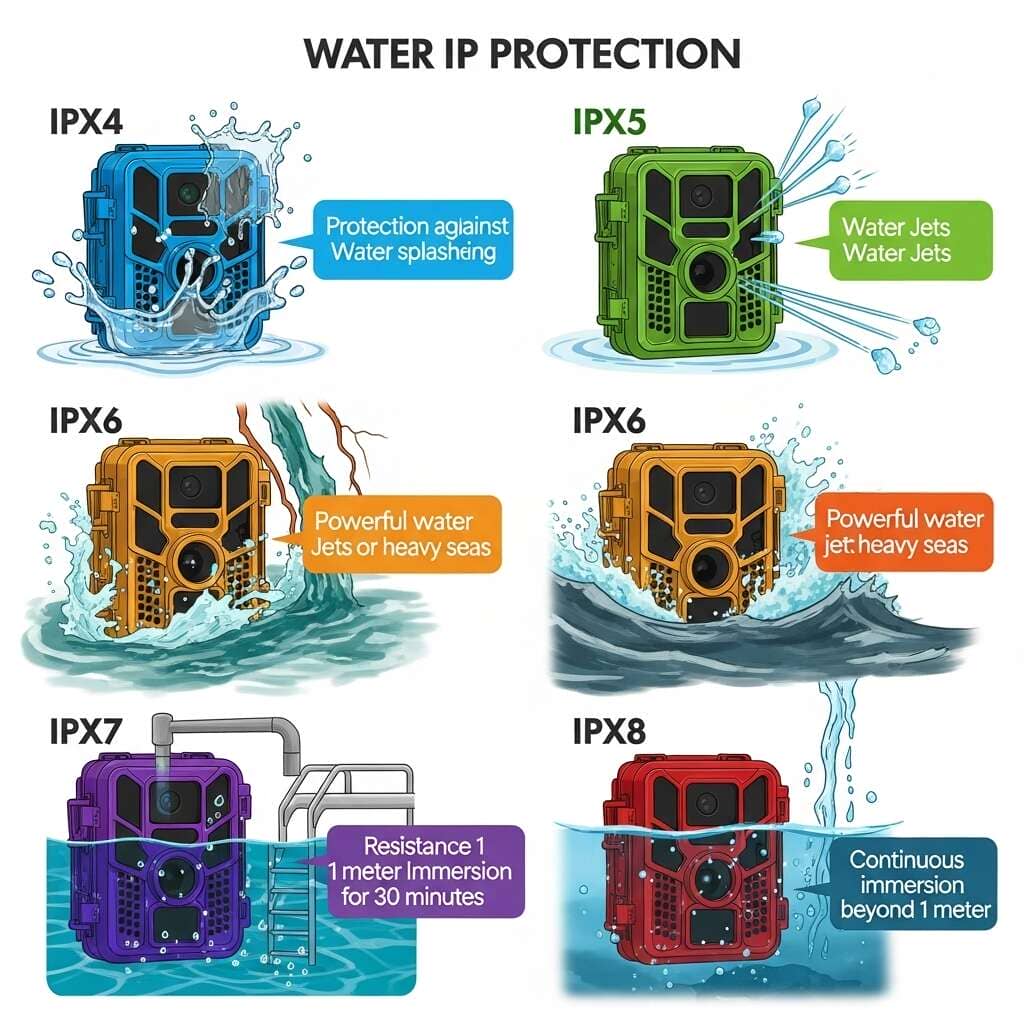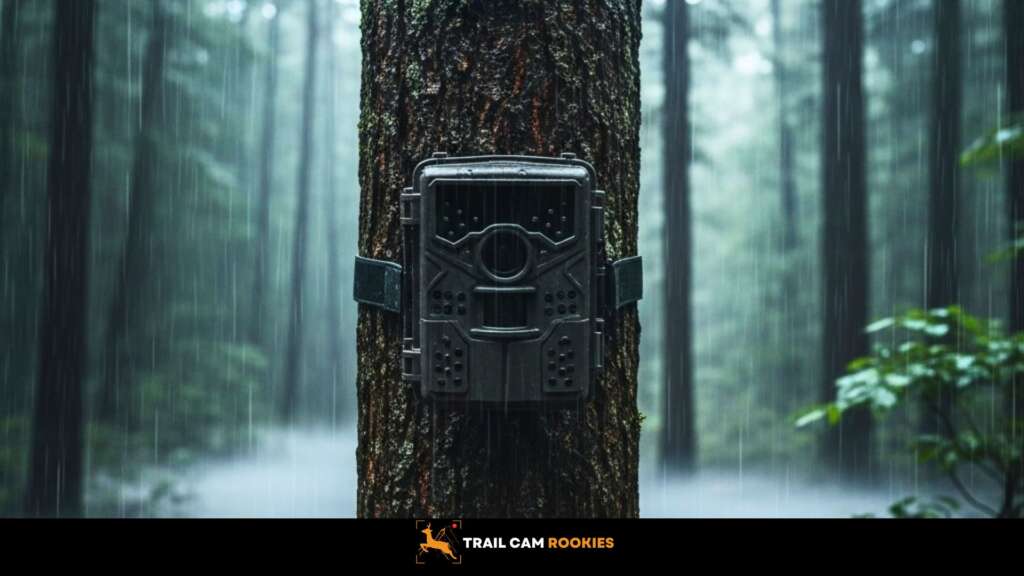What Makes a Trail Camera Weatherproof? Features to Look For
Trail cameras are essential tools for wildlife monitoring, hunting, and outdoor security. Their ability to withstand various weather conditions is crucial since they are often placed in exposed environments. A weatherproof trail camera is designed to resist rain, snow, humidity, and dust, ensuring reliable operation regardless of the elements.
Understanding what makes a trail camera weatherproof helps you select a model that can endure outdoor challenges without frequent maintenance or failure. Key weatherproof features protect internal electronics from moisture and physical damage caused by environmental factors.
In this article, you will discover:
- The difference between weatherproof and waterproof trail cameras.
- Essential features that contribute to a camera’s weather resistance.
- How to choose the right weatherproof trail camera based on your specific needs.
This guide aims to equip you with practical knowledge to make an informed decision when investing in a trail camera for rugged outdoor use. If you’re looking for some great options, check out these Best Trail Camera Deals that can help you save big while getting a quality product!
Understanding Weatherproof Trail Cameras
Explanation of Weatherproof vs. Waterproof
Trail cameras are generally designed to be weatherproof rather than fully waterproof.
While weatherproof cameras can withstand rain, snow, and moisture, they should not be submerged in water.
The distinction lies in the level of protection each offers against varying degrees of exposure to water and other elements.
Significance of IP Ratings
The Ingress Protection (IP) rating system is crucial in determining the water resistance levels of trail cameras. An IP rating consists of two numbers; the first indicates protection against solid objects like dust, while the second denotes resistance to liquids such as water.
For trail cameras, a minimum IPX4 rating is recommended for protection against water splashes from any direction.

Common IP Ratings for Trail Cameras
- IPX4: Protection against water splashes.
- IPX5: Water jets from all directions.
- IPX6: Powerful water jets or heavy seas.
- IPX7: Immersion up to 1 meter for 30 minutes.
- IPX8: Continuous immersion beyond 1 meter.
Understanding these ratings helps you choose a trail camera that meets your specific weatherproofing needs and ensures reliable performance in outdoor environments.
Also Read > Trail Camera with Wifi – Top 6 Picks for 2025 That Will Make You Say, “WOW!
Key Features That Make a Trail Camera Weatherproof

1. Sealed Housings
Sealed housings play a crucial role in protecting the internal components of a trail camera from moisture and external elements. By creating a barrier between the sensitive electronics and the outside environment, sealed housings prevent water, dust, and debris from infiltrating the camera.
The advantages of sealed housings are abundant when it comes to ensuring the reliable performance of a trail camera, especially in harsh weather conditions. These features help maintain the integrity of the camera’s internal circuitry and optics, prolonging its lifespan and functionality.
By incorporating sealed housings into their design, trail cameras can withstand varying weather conditions and environmental challenges without compromising performance or durability. This essential feature shields the intricate technology inside from potential damage caused by exposure to moisture or other external factors, ensuring that your camera remains operational even in the toughest outdoor settings.
2. Durable Seals and Gaskets
Seals and gaskets are essential for keeping moisture out of a trail camera’s sealed housing. They act as barriers, preventing water, dust, and other elements from reaching the delicate internal electronics. Even the toughest materials can’t fully protect the camera from moisture damage without effective seals and gaskets.
The Importance of Seals and Gaskets
- Moisture Protection: Seals and gaskets stop water from getting inside the camera.
- Dust Resistance: These components also keep dust out, which can harm the camera’s performance.
- Environmental Defense: They block other environmental factors like dirt or debris that could affect the camera.
Signs of Wear to Look Out For
Over time, seals and gaskets can show signs of wear due to exposure to the elements. Here are some indicators that they may need replacing:
- Cracks: Look for any visible cracks in the seals or gaskets.
- Hardening: If they feel stiff or rigid instead of flexible, it’s a sign of deterioration.
- Deformation: Any unusual shapes or bulges in these components indicate damage.
When seals and gaskets fail, water can enter the camera, causing corrosion, malfunctioning sensors, or even complete failure. Trail cameras exposed to extreme weather conditions without proper sealing are at a higher risk of performance problems and shorter lifespan.
The Role of Material Quality
The quality of seals and gaskets differs between trail camera models. Some use advanced rubber compounds or silicone materials that remain flexible and resilient despite temperature changes. Others may rely on simpler materials that break down more quickly when exposed to harsh conditions like freezing cold or intense heat.
Choosing a trail camera with well-designed durable seals and gaskets ensures ongoing protection from environmental wear while working in harmony with its tough construction materials and sealed housings. This combination is crucial for maintaining long-lasting moisture protection and dependable outdoor performance in various weather situations.
3. Rugged Construction Materials
When choosing a weatherproof trail camera, it’s important to consider the following features:
1. Types of materials
Weatherproof trail cameras are usually made from tough materials like high-grade plastics, reinforced polymers, and metal alloys. These materials are selected because they can endure harsh outdoor conditions and provide long-lasting protection for the camera’s internal parts.
2. Benefits of robust construction
Choosing a trail camera with sturdy construction has several benefits for outdoor use:
- Increased durability: Cameras made with strong materials can withstand impacts, extreme temperatures, and rough handling in different environments.
- Protection from physical damage: This solid construction not only safeguards the camera from being damaged but also improves its resistance to moisture and corrosion over time.
By prioritizing cameras with rugged construction materials, you can invest in a trail camera that guarantees longevity, environmental resilience, and reliable performance even in challenging weather conditions.
Choosing the Right Weatherproof Trail Camera for Your Needs
When selecting a suitable weatherproof trail camera, there are several key factors to consider to ensure it meets your specific outdoor monitoring requirements:
1. IPX4 Rating Significance
Look for cameras with at least an IPX4 rating, offering protection against water splashes from any direction. This rating ensures the camera can withstand light rain and moisture without compromising its functionality.
2. Protective Housing Options
Explore additional protective housing options available for certain trail camera models. These housings provide enhanced durability during extreme weather conditions, such as heavy rain or snow, safeguarding the camera from potential damage.
3. Battery Life
Consider the battery life of the trail camera, especially if you plan on extended outdoor deployment without frequent maintenance. Opt for models with long-lasting batteries or energy-efficient features to ensure uninterrupted monitoring in remote locations.
4. Image Capabilities and Trigger Speeds
High-quality image capabilities and fast trigger speeds are essential for effective wildlife monitoring. Choose a trail camera that offers clear images and videos with sufficient resolution, along with quick trigger speeds to capture wildlife activity promptly.
By prioritizing these features during your selection process, you can find a weatherproof trail camera that not only withstands harsh environmental conditions but also delivers reliable performance for your outdoor monitoring needs.
Maintaining the Weatherproof Performance of Your Trail Camera Over Time
Keeping your trail camera functioning reliably in wet environments demands attention to proper placement practices, regular inspection, and sometimes the use of weatherproof cases. These steps help you avoid costly damage and maintain peak performance.
Proper Placement Practices
Position your trail camera in locations that reduce direct exposure to water. Avoid low spots where rainwater can pool or areas prone to heavy splashing. Mounting it under natural cover such as tree branches or rocky overhangs helps shield it from rain and snow. Angling the camera slightly downward also encourages water runoff instead of accumulation on the device.
Regular Inspection
Frequent checks are essential to catch early signs of moisture intrusion or seal degradation. Open the camera periodically to inspect seals, gaskets, and battery compartments for any dampness or corrosion. Look for cracks or wear on the housing that could compromise waterproofing. Cleaning dirt and debris off seals improves their effectiveness, preventing water ingress before it becomes a problem.
Weatherproof Cases
In regions prone to extreme weather—heavy rain, snowstorms, or ice—using dedicated weatherproof cases provides an extra layer of protection. These enclosures are designed to withstand harsh conditions beyond the camera’s built-in defenses. They help prevent physical damage while maintaining sensor functionality and access to controls.
Adopting these maintenance routines extends your trail camera’s lifespan and ensures consistent operation during unpredictable weather. Proper care lets you rely on your equipment without interruption when monitoring wildlife or securing outdoor spaces.
Conclusion
Investing in a high-quality weatherproof trail camera is essential for capturing stunning wildlife moments and monitoring outdoor activities. By following proper care practices, you can ensure its optimal performance and longevity.
Before making a purchase decision, take the time to explore different models available in the market. Each camera has its own unique features and specifications that may suit your specific needs better.
Remember, the right trail camera can make all the difference in your outdoor adventures. Happy exploring!


